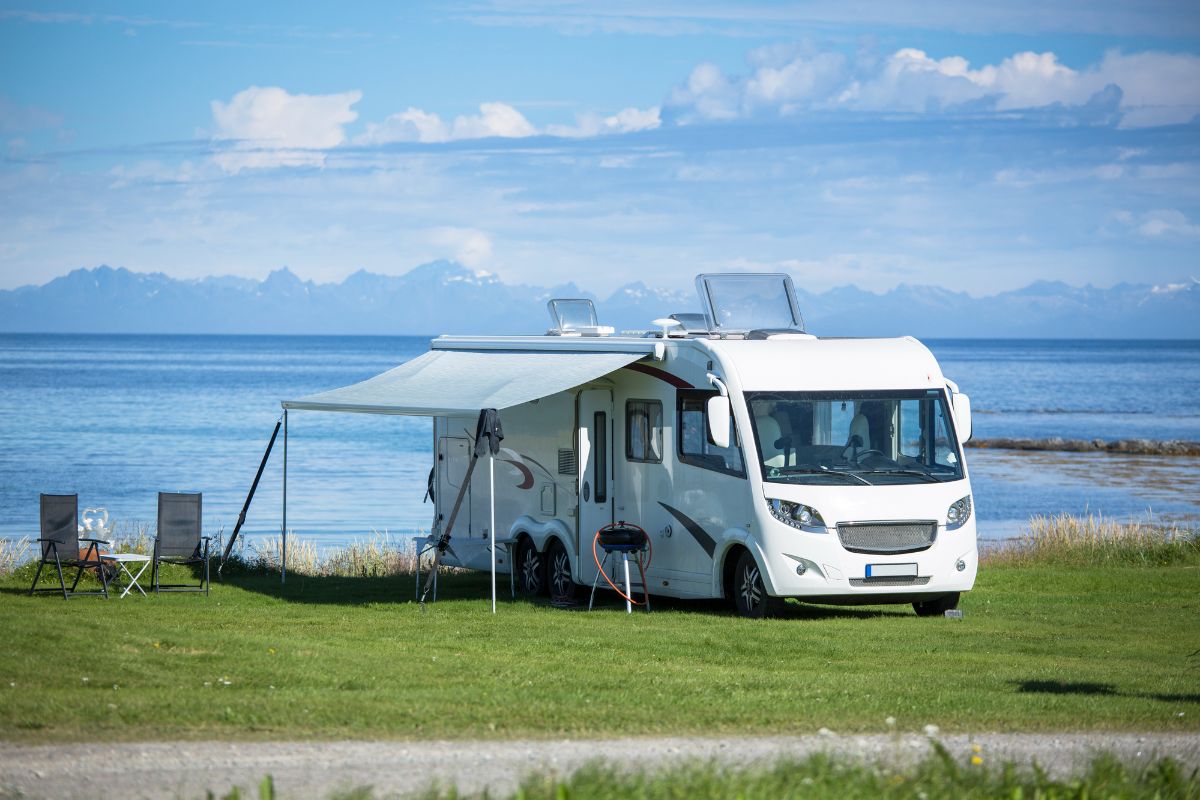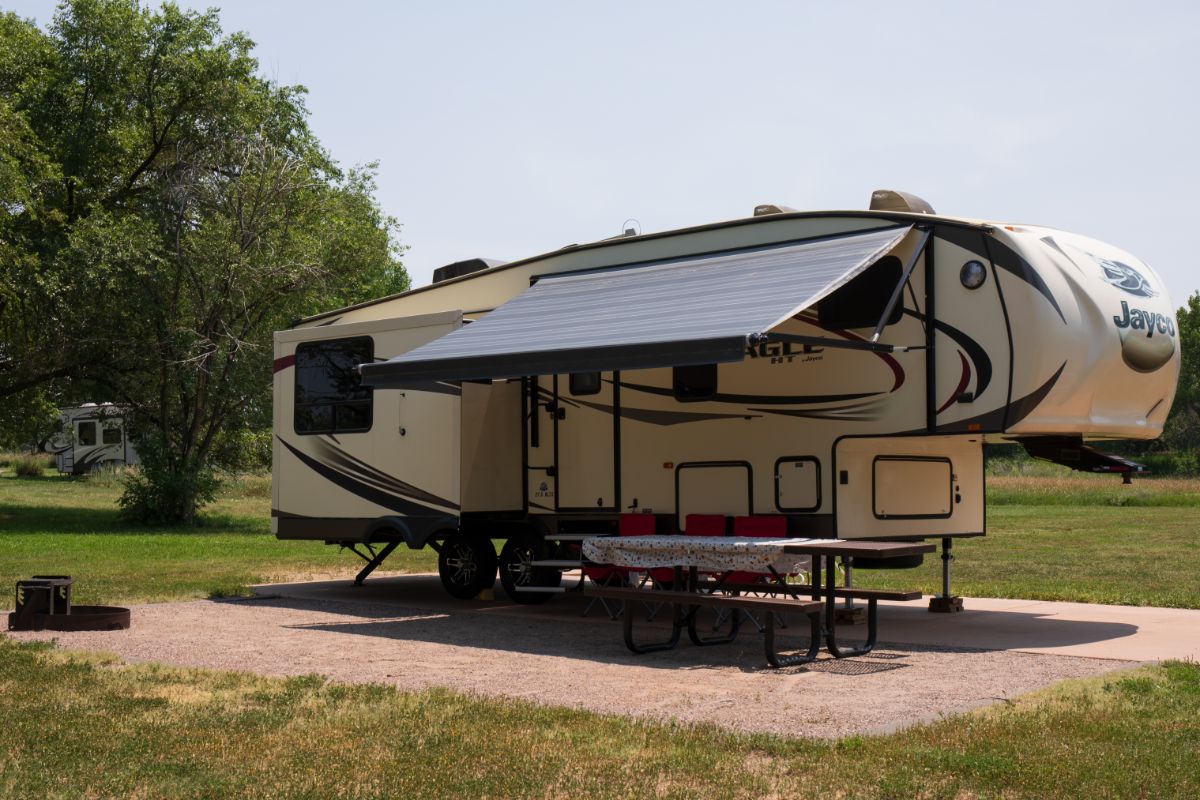
Living as a digital nomad or choosing to invest in an RV has become increasingly popular and trendy in the past decade.
Whether you own an RV for camping getaways or if you are thinking of making your RV your permanent home, you may want to purchase an awning for your recreational vehicle at some point. Choosing between vinyl or acrylic awning can be difficult if you are unsure of where to begin or the benefits of both.
While choosing between acrylic or vinyl awnings will come down to your own preferences as well as your traveling style, acrylic awnings can offer a longer-lasting solution that is more breathable and durable for those who use an awning on a regular basis.
What is a Vinyl RV Awning?
A vinyl awning uses fabric that is extremely tightly woven together, creating essentially a waterproof surface. The vinyl awnings are ideal for those who live in or travel to extremely damp and wet regions.
What is an Acrylic RV Awning?
An acrylic awning also includes woven material, similar to a vinyl awning. However, this material is not as tightly woven, providing more breathability and airflow than a vinyl awning in most cases.
How are Vinyl and Acrylic Awnings Different?
Both vinyl and acrylic awnings have plenty to offer when it comes to camping, traveling, or even living out of an RV.
Features

A vinyl awning is often promoted as waterproof, which is why it is so appealing to those who live in wet or damp climates. Vinyl awnings can also be found much cheaper, especially if you are purchasing an old or outdated awning for your camper or RV.
An acrylic awning is similar to a vinyl awning in many ways, although typically, acrylic awnings are not always as waterproof or foolproof as vinyl awnings. However, while acrylic awnings are also woven together using fabric, they are done so in a more relaxed and casual manner, not as tight as their vinyl awning counterparts.
Materials
Vinyl is technically considered a type of plastic, although it is woven together tightly as a fabric when creating materials such as awnings for RVs and other homes or moving vehicles.
Acrylic awnings also use acrylic, another type of plastic, but one that is more breathable and not as tightly woven.
Design

Vinyl awnings typically look like completely solid fabrics that cannot breathe or be penetrated. The awnings may be square in shape or they may be curved and elongated, depending on where the awning is placed and the ground it is meant to cover.
With a vinyl RV awning, you can expect more coverage, and less light is permitted, which is ideal for those who are in search of complete shade with their RV.
Acrylic awnings are a bit more updated and come in a wide range of styles, patterns, colors, and overall types. With an acrylic awning, you can choose from retractable awnings as well as attachable awnings, depending on the size of your RV and the size of the awning you are interested in using.
With an acrylic awning, you will often have much more choice when it comes to choosing a pattern, color, or design that is just right for you.
Cost Differences

Before investing in a brand new awning of any kind for your RV, it is important to first compare your options while also learning about the cost differences that are likely between vinyl and acrylic solutions.
Typically, an RV awning will cost anywhere between $550 and $1650, depending on the type of awning material you choose, the material you prefer, as well as the overall size of the awning itself.
In most cases, if you are looking for an awning on a budget, your best option is to consider a vinyl awning solution. A vinyl awning may run you as low as $160 for the fabric, especially if you are looking to use the awning over a small designated area outside of your RV.
You can also opt to build your own awning, but you will require the mounting gear as well as the necessary tools and screws to secure your awning in place, especially if you are building a semi-permanent or a permanent fixture.
If you choose to build your own RV awning, you can do so by ordering specific sheets of acrylic or vinyl fabric, depending on whether you are choosing to build a standalone structure or an awning that is also retractable and can be moved at any time.
Benefits of Each

When choosing between vinyl or acrylic awnings for your RV, both do offer benefits and advantages. Some of the most notable benefits of each type of awning for RVs today include:
Vinyl Awnings
A vinyl awning is not only durable and waterproof, but it is often much cheaper and more affordable than modern acrylic awnings, which are available as freestanding awnings or even permanent RV awnings. Choosing vinyl is optimal for those who live in an area where rainy climates are considered normal, as vinyl is much less breathable and open than acrylic awnings.
It is important to remember that by choosing a vinyl awning, you will need to maintain your awning more than a standard acrylic awning. Due to the vinyl awning’s reduced airflow and breathability, the awning will require ongoing cleaning to prevent the buildup of mold, mildew, algae, bacteria, and more.
Frequently, inspection and cleaning of vinyl awnings is always recommended, especially for those who are living outside of their RV or consider themselves seasoned travelers.
It is also essential to remember that vinyl may be a bit weaker than acrylic, especially if you are using an awning that is older, outdated or one that has been used repeatedly over the years. Vinyl is more likely to rip or tear over time, which is why constant ongoing maintenance of any vinyl awning is imperative.
Acrylic Awnings
Acrylic awnings are also woven together using acrylic plastic. However, acrylic awnings are not typically woven together as tightly as traditional vinyl awnings, even those designed for RVs and traveling purposes.
With an acrylic awning, you can enjoy a breathable fabric that also provides protection from the sun and heat, which is optimal for those who are traveling through the desert or through warmer regions. If you are planning to spend most of your time in humid, wet climates, however, choosing a vinyl awning is not a bad idea.
History of Each

The invention of traditional awnings can be traced all the way back to the time of Ancient Egypt and other regions scattered throughout the Middle East. Today, both vinyl and acrylic awnings are more popular than ever, for both RV and homeowners alike.
Vinyl awnings were first introduced to popular culture during World War II, and are still used in both business and personal settings alike. The use of acrylic and polyester was introduced later, which has since evolved into an entire market for acrylic awnings as well as retractable awnings made of acrylic material.
When it comes to traveling in an RV, we prefer acrylic awnings, unless we are spending most of our time in muggy and humid areas.
Taking the time to learn about both vinyl and acrylic awnings can help you to choose the right fabric, material, and solution for your own RV or camper. Whether you enjoy taking weekend getaway trips to your favorite cabin or if you are living on the road full-time, choosing the right RV awning can make all of the difference when it comes to how you are able to enjoy your time on the road in the great outdoors.


